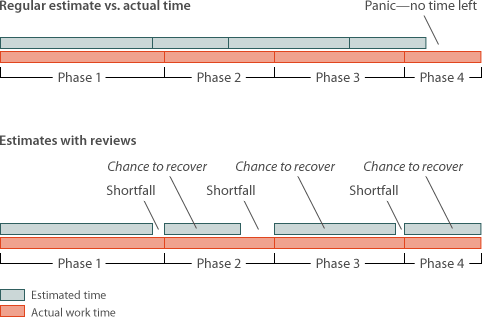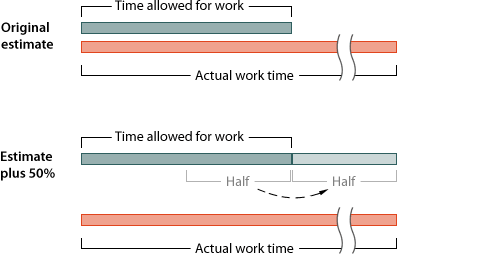Passing The Holy Milestone: How To Meet Deadlines
For too many projects, there comes a time when every action taken, every decision and sacrifice made, is spurred on by pressure to finish. Tempers seem to shrink along with the available days, talk about “high standards” gives way to “good enough,” and people realize that deadlines are aptly named. During the last-minute crunch, someone may well wonder, how did it come to this? Could it have been prevented? Every Web project has deadlines. But not every designer or developer deals with them the same way.
Further Reading on SmashingMag:
- How To Communicate Effectively In IT Projects
- Critical Mistakes Freelancers Make
- Guidelines for Successful Communication With Clients
- Fight The System: Battling Bureaucracy
What Causes A Deadline To Break?
Because a deadline marks the end of a project, everyone involved in the project must understand the deadline’s role. Most projects follow a schedule or have an estimated date by which they must be completed. The concept is simple then: when the work takes longer than expected, deadlines get missed.

Of course, projects can be more complicated in their details. Unexpected technical problems and unanticipated changes will affect the amount of work required. Sometimes other tasks take priority. Sometimes the time estimate wasn’t considered carefully enough.
Whatever the cause, too much work needs to be done in the available time. That’s the problem, but not the challenge.
Rate Deadlines By Severity Of Consequences
The hardest deadlines are tied to events that cannot be moved, such as a date promised to the public, an upcoming trade show or a date stipulated in a contract. Retailers know that their holiday sales must end at Christmas, and theater owners can expect movie-goers to be upset if a 1:00 pm showing doesn’t start until 2:00. Likewise, if a website is tied to a time-sensitive event, its relevance is lost once the event has passed. Hard deadlines have clear consequences when missed.

Deadlines tied to less public events are no less real, but a project will soldier on if the deadline slips. Company-imposed target dates, for example, rely less on public demand than on the temperament of managers. Meetings routinely start 10 minutes late because “something came up.”
The softest deadlines lack teeth or are set at some vague point in the future. That’s not always bad: not every missed deadline will cause a life-or-death crisis. But the same methods of solving the crisis apply. There are many strategies for handling a last-minute crisis. Most involve planning, setting priorities and knowing one’s limits.
Strategies For Preventing Deadline Crises
The beginning of a project is a great time to prevent problems later on.
The first solution is both obvious and difficult: do not take on a project that cannot be completed in the given time. Declining paid work requires discipline and confidence, but if the deadline is impossible, then the project may not be worth the money. Money cannot replace time.
Because deadlines with consequences are taken more seriously, keep a written list of definitive reasons why certain tasks must be completed by a given date. Losing money, customers and other assets create real incentives to work.
Schedule deadlines as specific tasks, not the ends of phases. Rather than “Content will be completed by 4 April 2010,” state “Review the content over lunch on 4 April 2010.” This ties the deadline to an event at which results must be shown. Mini-deadlines tied to specific events are more powerful than general statements.

Plan For Unpleasant Surprises
Incentive may not be the problem, though. Unexpected problems cause many people to break deadlines. Their unpredictability make these problems hard to plan for, and good intentions don’t help you see the future. The key is to recognize that, whatever their nature, problems will likely occur.
If everything seems accounted for in the project plan, then invent a problem. Keep it realistic: “reshoot staff photos” is more likely than “spontaneous server combustion,” but it doesn’t really matter. The point is to create extra time to allow for a deadline crisis. One rule of thumb is to add between half and all of a project’s expected duration. That is, increase the full time that has been budgeted by between 50 to 100% to allow for surprises.
A plan of time estimates for major tasks in a project could look something like this:
| Task: | Time allotted: |
|---|---|
| Content audit | 15 hours |
| Develop content strategy | 15 hours |
| Make WordPress theme changes | 20 hours |
| Import data from old website | 15 hours |
| Test on multiple browsers | 5 hours |
| Total | 70 hours |
Being conservative, let's take half of 70, which is 35. Now we invent a problem: say, having to retype all content from print-outs. Is 35 hours for that ridiculous? Perhaps. But obstacles are unexpected by nature, and they always steal time from an otherwise ideal budget.

A line item needs to be added to the budget. It could be “Time to make changes” or “Allowance for unknowns.” The description isn’t as important as the fact that you have planned for surprises.
Is half of the original budget too much? It may drive cheaper clients away, but overestimating and finishing under the deadline is better than the alternative.
Mitigate A Deadline’s Threat By Adding Other Deadlines
Implement mini-deadlines within a project’s timeline. Mini-deadlines minimize last-minute problems by serving as checkpoints to gauge how far off track the schedule is, if at all, at certain phases.
- Start While the project is fresh in everyone’s mind, a schedule for the other phases should be set.
- First quarter Everyone involved should have a sense of whether they can work together. Work begins, and the pristine project on paper comes up against the sticky details of reality.
- Halfway point The bulk of the work happens here. If you doubled your estimate to account for surprises, you would actually be aiming to launch the project right now.
- Third quarter If everyone pushed to launch by the halfway point, then almost everything should be done by now. But it rarely is.
- Deadline Launch the project.
- Review Win or lose, everyone should ask what should have happened at each phase of the project? What should have been done to meet each mini-deadline along the way?
Notice that mini-deadlines are based on time, not task. Tasks have a way of expanding, of taking up more time than planned, which mini-deadlines should prevent. Think of a mini-deadline as a chance to review the project’s timeline. While this approach may not entirely stave off a deadline crisis, it gives you opportunities to catch and correct problems along the way.
Plan Sacrifices In Advance
Every project has absolute requirements, which are essentially the reasons the project exists at all or the problems it is designed to solve. But many also have supplemental requirements. If a project requires A, B and C, then by all means include D, E and F, but only with the understanding that they might have to wait.
For example, a newsletter is an important marketing tool for an e-commerce website, but less important than an easy-to-use cart and secure log-in page. Likewise, the top priority for a photo gallery should be to present photos. If the deadline is looming and the AJAX is buggy, then perhaps the blog should wait.
Marking certain features as secondary provides relief when things go wrong. These features don’t need to be cut, but their deadlines should be later than those of the core project.
Practice
Measure the rate at which you work by timing how long you take to perform various tasks. You want to figure out how much time you need to comfortably perform each task, not how fast you can get it done.
For example, the schedule might allow for 30 minutes to create a favicon. But in reality, it consumes 8 hours.
Wait a minute. Eight hours for a measly 16x16-pixel graphic? Isn’t that… excessive?
That’s not the point. You’re not learning the rate at which you work so that you can gasp in embarrassment at the result. Workflow efficiency can be improved later. The question is, how much time are you comfortable with right now? In this case, it’s 8 hours.
Deadlines aren’t the problem. Problems arise when the work outweighs the allotted time. Learning how long you take to accomplish certain tasks is the best way to set a realistic schedule.
Conclusion
Not every deadline drama can be prevented, but even the worst can be dealt with professionally. Prepare for surprises, break up large tasks into manageable segments and prioritize. It’s a matter of respect: deadlines mean business. Do you?
How do you prevent deadline emergencies? What’s the worst problem you’ve faced under time pressure? What’s your greatest solution? Share your story in the comments below.




 Flexible CMS. Headless & API 1st
Flexible CMS. Headless & API 1st


